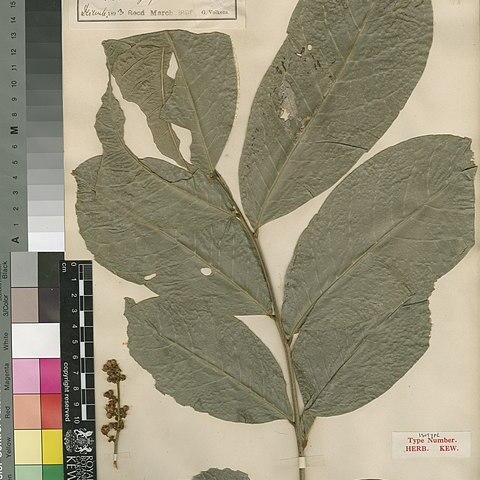Small tree or shrub 1.2–12 m. tall, with simple trunk; bark brownish grey.. Leaves with petiole 5–20 cm. long and rhachis 15–40 cm. long, both mottled brown or green and straw-coloured towards the base when dry, adpressed-pubescent when young; petiolules 3–10 mm. long, at first pubescent; leaflets in (3–)5–7 pairs, subopposite or alternate, oblanceolate to oblong-elliptic, 4–27(–30) cm. long, 1.9–10.2(–16) cm. wide, acuminate (with actual tip rounded) or broadly rounded to truncate at the apex, cuneate to rounded at the base and often asymmetric, glabrous; lateral nerves in 8–13 pairs, prominent and often drying yellowish beneath; venation prominently raised-reticulate.. Inflorescences 9–30(–60) cm. long, with spreading or ascending main branches up to 35 cm. long, ± glabrous or ferruginous (in life and dry) pubescent, sometimes only at the nodes; flowers in dense clusters on very short side branchlets, pedicels said to be ‘brown at base but white above joint’ 0–3 mm. long, lengthening to 5 mm. in fruit.. Sepals drying cream or brown, 4.5 mm. long, 2.8 mm. wide, the outer strongly overlapping the inner, petaloid, glabrous to densely dark ferruginous-pubescent outside, but always ciliate.. Petals white or cream, sometimes tinged pink, obovate, 4–5 mm. long, 2.5 mm. wide, shaggy ciliate below, scale 3 mm. long.. Stamens 14–18, with filaments white hairy.. Fruit ± globose, 1.2–1.5 cm. long, 1.2–1.8 cm. wide, usually only one mericarp developing, the two aborted ones persistent at the base, glabrous.. Seed 1 cm. long.
More
A small tree. It grows 2-6 m tall. It can be 10 m tall. It has a single trunk. The bark is grey brown. The leaves have an even number of leaflets. There are 8-12 leaflets along the stalk. The flowers are in groups 9-30 cm long. The flower are small and white or cream. The fruit is round and 1.5 cm long by 1.8 cm wide. There are 2 varieties.
It is a tropical plant. It grows in the undergrowth in mountain rainforest. It suits humid locations. In Tanzania it grows between 1,100-2,300 m above sea level.
More
Evergreen forest, moist or dry riverine forest, and upland rainforest, at elevations from 1,100-2,300 metres.


